What is phytophotodermatitis?
Phytophotodermatitis is a phototoxic reaction to contact with certain plants.
Phytophotodermatitis usually occurs during spring or summer after some outdoor activity on a sunny day during which there has been contact with one of the responsible plants.
Its name has 3 components: phyto (plant), photo (light) and dermatitis (inflammatory eruption)
What are the clinical features of phytophotodermatitis?
During the acute inflammatory stage, itchy blisters and red patches appear on exposed skin, usually the forearms or legs. These are often unevenly and oddly distributed. Linear Lesions are characteristic. In some cases, the inflammatory phase is not observed.
Acute phytophotodermatitis
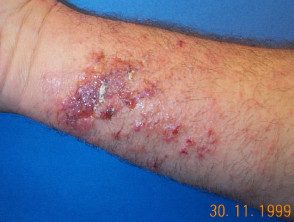
Acute phytophotodermatitis, followed by hyperpigmentation.

Acute phytophotodermatitis
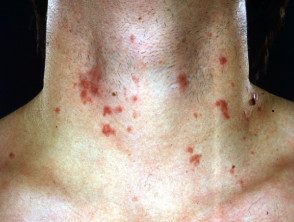
Acute phytophotodermatitis

Acute phytophotodermatitis
After a few days, the redness and blisters stabilize, but are replaced by unsightly and strange. pigmentation in the same places Pigmentation is more pronounced in dark skin compared to light skin. Is post-inflammatory Pigmentation can persist for weeks or months.
Pigmentary phytophotodermatitis

Pigmentary phytophotodermatitis
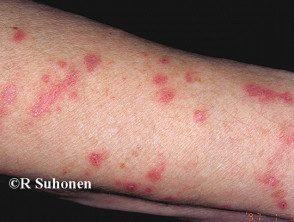
Pigmentary phytophotodermatitis

Pigmentary phytophotodermatitis

Pigmentary phytophotodermatitis
What Causes Phytophotodermatitis?
Phytophotodermatitis is induced by the action of long wavelengths. Ultraviolet radiation (UVA) in a chemical plant called furocoumarins (psoralens) on the surface of the skin. Contact with the plant, fruit, or vegetable may have been brief and inadvertent. The reaction depends on:
- The amount of juice or sap on the skin.
- The amount of furocoumarins in the plant, which is believed to be produced in response to fungal attack
- Amount of exposure to UVA rays. UVA levels are higher when during the middle of the day, in midsummer and at high altitude
The reaction provokes inflammation at epidermis (contact dermatitis) and activation of melanocytes (pigment cells) to produce melanin pigment.
Pigmentation due to phytophotodermatitis is in part epidermal melanosis (that is, the pigment is inside the skin cells) and partly dermal melanosis (that is, the pigment is deeper in the skin).
What plants cause phytophotodermatitis?
Responsible plants include:
- Parsley
- Parsnips
- Celery
- Carrot
- FIG
- Lime
- Lemon
- Bergamot oranges
- Common rue
- Several species of wild flowers (umbelliferous), such as hogweed.
Plants that cause phytophotodermatitis
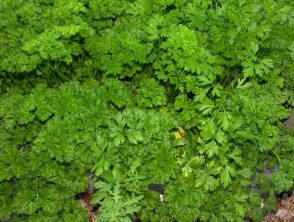
Parsley

Parsnip

Lime
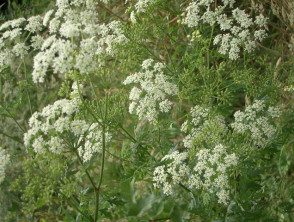
Wild carrot
What is berloque dermatitis?
Berloque dermatitis (or trinket dermatitis) is a special form of phytophotodermatitis caused by exposure to perfumes. These perfumes contain a high concentration of bergapten (5-methoxypsoralens).
Berloque dermatitis is rare today, but it can arise if an older fragrance is applied to the skin. Current regulations restrict the concentration of bergapten to be below the threshold required to cause contact dermatitis or pigmentation.
Acute inflammatory dermatitis due to berloque dermatitis is sometimes unrecognized, and the patient may have striated pigmentation on the neck or wrist.
PUVA photoxicity
Photochemotherapy (PUVA) is a treatment for inflammatory skin conditions such as psoriasis and eczema. Treatment consists of taking psoralens by mouth or applying psoralens. solution to the skin, followed by exposure to UVA rays, under controlled circumstances.
PUVA has beneficial effects on skin diseases, but as it involves the same process that occurs in phytophotodermatitis, it can cause excessive pigmentation. This can be quite noticeable after current or PUVA bath water.
Phototoxic pigmentation due to topical PUVA
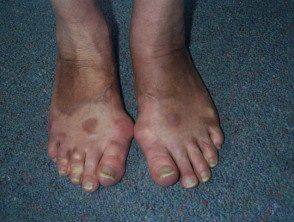
Topical PUVA followed by sun exposure has caused phototoxic pigmentation on uncovered skin.
What is the treatment for phytophotodermatitis?
When pigmentation occurs, the inflammatory phase of phytophotodermatitis is over. This means that anti-inflammatory Treatments like topical steroids are only helpful in the early phase of redness and blistering.
The post-inflammatory pigmentation that follows phytophotodermatitis responds poorly to treatment with bleaching creams. It gradually fades over weeks or months. By using covering clothing and broad spectrum sunscreens, the affected skin must be protected from further sun exposure, which could darken pigmentation. Can be disguised with camouflage cosmetic makeup.

